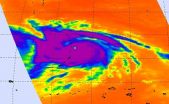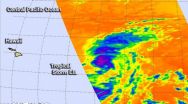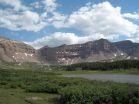(Press-News.org) Two of NASA's heliophysics missions can now claim planetary science on their list of scientific findings. A group of scientists used the Venus transit - a very rare event where a planet passes between Earth and the sun, appearing to us as a dark dot steadily making its way across the sun's bright face - to make measurements of how the Venusian atmosphere absorbs different kinds of light. This, in turn, gives scientists clues to exactly what elements are layered above Venus's surface. Gathering such information not only teaches us more about this planet so close to our own, but it also paves the way for techniques to better understand planets outside our solar system.
Transits of Venus are so rare that they only happen twice in a lifetime. About every 115 years, Venus will appear to cross over the face of our home star twice, with eight years passing between the pair of transits. This stunning phenomenon is not only incredible to watch, but it provides a unique opportunity for scientific observations of one of our nearest neighboring planets.
NASA'S Solar Dynamics Observatory, or SDO, and the joint Japanese Aerospace Exploration Agency and NASA's Hinode mission took pictures of the entire event in several wavelengths of light. A team of scientists led by Fabio Reale of the University of Palermo used these pictures to watch the backlit planet as it crossed in front of the sun. By observing the planet's atmosphere in different wavelengths of light during its journey, they learned more about what kinds of atoms and molecules are actually in its atmosphere. This work was published in Nature Communications on June 23, 2015.
Just as on Earth, each of the layers of Venus' atmosphere absorb light differently from one another. Some layers may completely absorb a certain wavelength of light, while that same wavelength can pass right through another layer. As Venus passes across the face of the sun -- which emits light in almost every wavelength of the electromagnetic spectrum -- scientists get a rare chance to see how all different types of light filter through Venus's atmosphere.
A layer in the upper atmosphere around Venus--called the thermosphere--absorbs certain high-energy wavelengths of light. When looking at the planet against the sun in one of these high-energy wavelengths, the thermosphere will appear opaque, rather than transparent as it does in visible light.
"Radiation goes into the atmosphere and is absorbed, creating ions and a layer of the atmosphere called the ionosphere," said Dean Pesnell, SDO project scientist at NASA's Goddard Space Flight Center in Greenbelt, Maryland. Because the energy in this light is captured by the ions, it is not re-emitted on the other side. In certain wavelengths, Venus's atmosphere is as solid as a wall, blocking light from traveling to our eyes. To our telescopes, the atmosphere is as dark as the planet itself -- so, Venus will appear to have a different size, depending on the wavelength of the telescope's pictures.
Reale and his team chose images of the Venus transit taken in several X-ray and ultraviolet wavelengths and measured the apparent size of the planet to within several miles. For each set of pictures, the team calculated just how large the atmospheric blocking was--a measure of how high in Venus' atmosphere that particular wavelength of light is completely absorbed.
Because the various types of atoms absorb light slightly differently, the height of this light absorption lets scientists know how many and what types of molecules make up Venus's atmosphere. This information is important for planning missions to Venus, as those ions and molecules can change the amount of course-altering drag a spacecraft feels.
"Learning more about the composition of the atmosphere is very important for understanding the braking process for spacecraft when they enter the upper atmosphere of the planet, a process called aerobraking," said Reale.
The shape of Venus' atmosphere also gave scientists important clues to how the sun impacts the atmosphere. "If the atmosphere observed were asymmetric, that could tell us more about how the star is impacting the planet," said Sabrina Savage, NASA project scientist for Hinode.
During the transit, only the sides of the atmosphere could be seen, but they were particularly interesting areas. From the perspective of Venus, these were the areas where day turns into night and night turns into day--on Earth, these transition areas can host interesting effects in the ionosphere. The data from the Venus transit showed that these two transition areas are virtually the same.
"The planet appeared very round in all wavelengths," said Pesnell. "If the transition from day to night were different from the transition from night to day, you would expect a bulge in the atmosphere on one side of the planet."
Studying the Venus transit can also help improve studies of planets around other stars. Such exoplanets are often discovered by transits just like this, as we can detect the very small amount of light the planets block as they pass across their home star. The more we can observe transiting planets close to home the more it will teach us about how to study distant exoplanets that we can't currently see in as much detail. When instrument technology advances, we may be able to gather better information about the atmospheres of such exoplanets as well.
"In the future, there might be missions that have enough sensitivity to detect the difference in radius in different wavelengths," said Reale. "In particular, if there are exoplanets with an extremely thick thermosphere, the size difference in different wavelengths will be larger and there will be a better chance of detecting the change."
INFORMATION:
NASA's Aqua satellite passed over Supertyphoon Nangka on July 9 and provided a visible and an infrared view of the large storm.
At 0700 UTC (3 a.m. EDT) on July 9 a typhoon warning was in effect for Agrihan, Pagan and Alamagan in the northern Marianas. A tropical storm warning is in effect for Saipan and Tinian. Nangka passed over Alamagan.
The Atmospheric Infrared Sounder or AIRS instrument aboard NASA's Aqua satellite gathered infrared temperature data on Nangka on July 9 at 03:23 UTC (July 8 at 11:23 a.m. EDT). At the same time, the MODIS instrument took a visible ...
Studying the gastric cancers of 15 Southeast Asian patients, researchers at The Jackson Laboratory, the Genome Institute of Singapore and other institutions identified five recurrent fusion genes, one of which appears to lead to cellular changes involved in acute gastritis and cancer.
Worldwide, close to a million cases of gastric cancers are diagnosed each year, and some of the world's highest incidence rates are in Asia (particularly in Korea, Japan and China).
The researchers, led by JAX Professor Yijun Ruan, Ph.D., and Axel M. Hillmer, Ph.D., of GIS, published ...
LOS ANGELES (July 9, 2015) - After generating new brain tumor models, Cedars-Sinai scientists in the Board of Governors Regenerative Medicine Institute identified the role of a family of genes underlying tumor growth in a wide spectrum of high grade brain tumors.
"With these new genetic findings, our group of researchers plan to develop targeted therapeutics that we hope will one day be used treat patients with high grade brain tumors and increase their survival," said Joshua Breunig, PhD, a research scientist in the Brain Program at the Cedars-Sinai Board of Governors ...
Tropical Storm Ela was born in the western-most part of the Eastern Pacific Ocean but has become the Central Pacific's first named storm. NASA's Aqua satellite took a look at the storm that's already battling wind shear to survive.
After developing as a depression on July 8, Tropical Depression 4E crossed over the 140 degree West longitude line that separates the Eastern Pacific from the Central Pacific Ocean region. The depression strengthened into a tropical storm early on July 9, taking a name from the Eastern Pacific tropical cyclone list and being renamed Ela.
When ...
Traumatic spinal cord injuries are increasing with the population, and incidence is higher in older individuals, according to a Vanderbilt study that was published in the June 9 issue of the Journal of the American Medical Association.
The study, which analyzed data from 63,109 patients with acute traumatic spinal cord injury from 1993 to 2012, will help target specific populations for preventive measures, said lead author Nitin B. Jain, M.D., M.S.P.H, associate professor of Physical Medicine and Rehabilitation.
"We find that spinal cord injury as a result of falls is ...
MINNEAPOLIS / ST. PAUL (7/9/2015) -- Draining tropical peatlands for oil palm plantations may result in nearly twice as much carbon loss as official estimates, according to a new study by researchers from the University of Minnesota Institute on the Environment and the Union of Concerned Scientists in the journal Environmental Research Letters.
Peatlands -- waterlogged, organic soils -- have developed over thousands of years as carbon storage systems. In Southeast Asia, peat swamp forests cover about 250,000 square kilometers, a land area about the size of Michigan. In ...
Scientists at the University of East Anglia in collaboration with the University Pompeu Fabra in Barcelona have found a way to separate the medical benefits of cannabis from its unwanted side effects.
The research comes from the team that discovered how the main psychoactive ingredient in cannabis, known as THC, reduces tumour growth in cancer patients.
Their latest findings, published today in the journal PLOS Biology, reveal how the cognitive effects of THC are triggered by a pathway which is separate from some of its other effects.
That pathway involves both a ...
Neutralizing antibodies (Nabs) are immune proteins that recognize, bind to, and trigger the elimination of virus before it can establish a chronic infection. How to elicit a potent Nab response capable of protecting against different HIV subtypes and against different modes of infection is critical to the development of an AIDS vaccine. Two studies published on July 9th in PLOS Pathogens provide results on Nabs that could help guide vaccine design. One shows what type of Nab "repertoire" can be generated following superinfection, and the second one examines the efficacy ...
SALT LAKE CITY, July 9, 2015 - More than a quarter of the rain and snow that falls on continents reaches the oceans as runoff. Now a new study helps show where the rest goes: two-thirds of the remaining water is released by plants, more than a quarter lands on leaves and evaporates and what's left evaporates from soil and from lakes, rivers and streams.
"The question is, when rain falls on the landscape, where does it go?" says University of Utah geochemist Gabe Bowen, senior author of the study published today in the journal Science. "The water on the continents sustains ...
Global warming is putting the squeeze on bumblebees. In the most comprehensive study ever conducted of the impacts of climate change on critical pollinators, scientists have discovered that global warming is rapidly shrinking the area where these bees are found in both North America and Europe.
Researchers examined more than 420,000 historical and current records of many species of bumblebees--and confirm that bumblebees are in steep decline at a continental scale because of climate change. The new research is reported in the journal Science.
ECONOMIC THREATS
This ...




